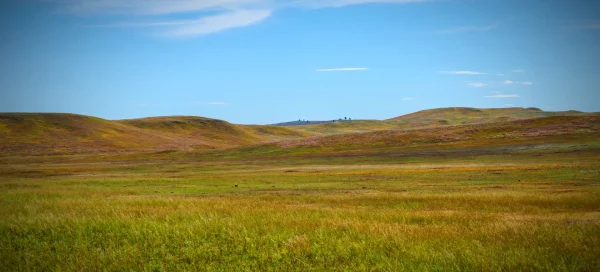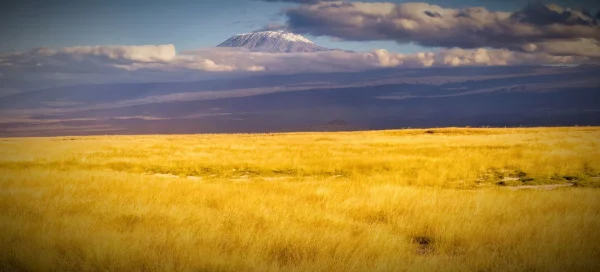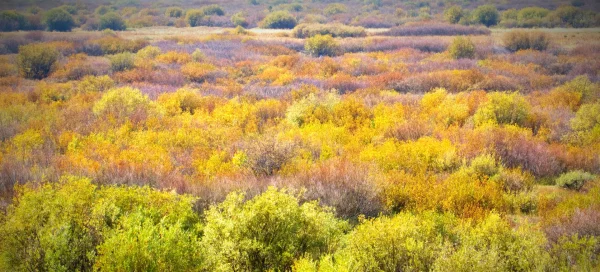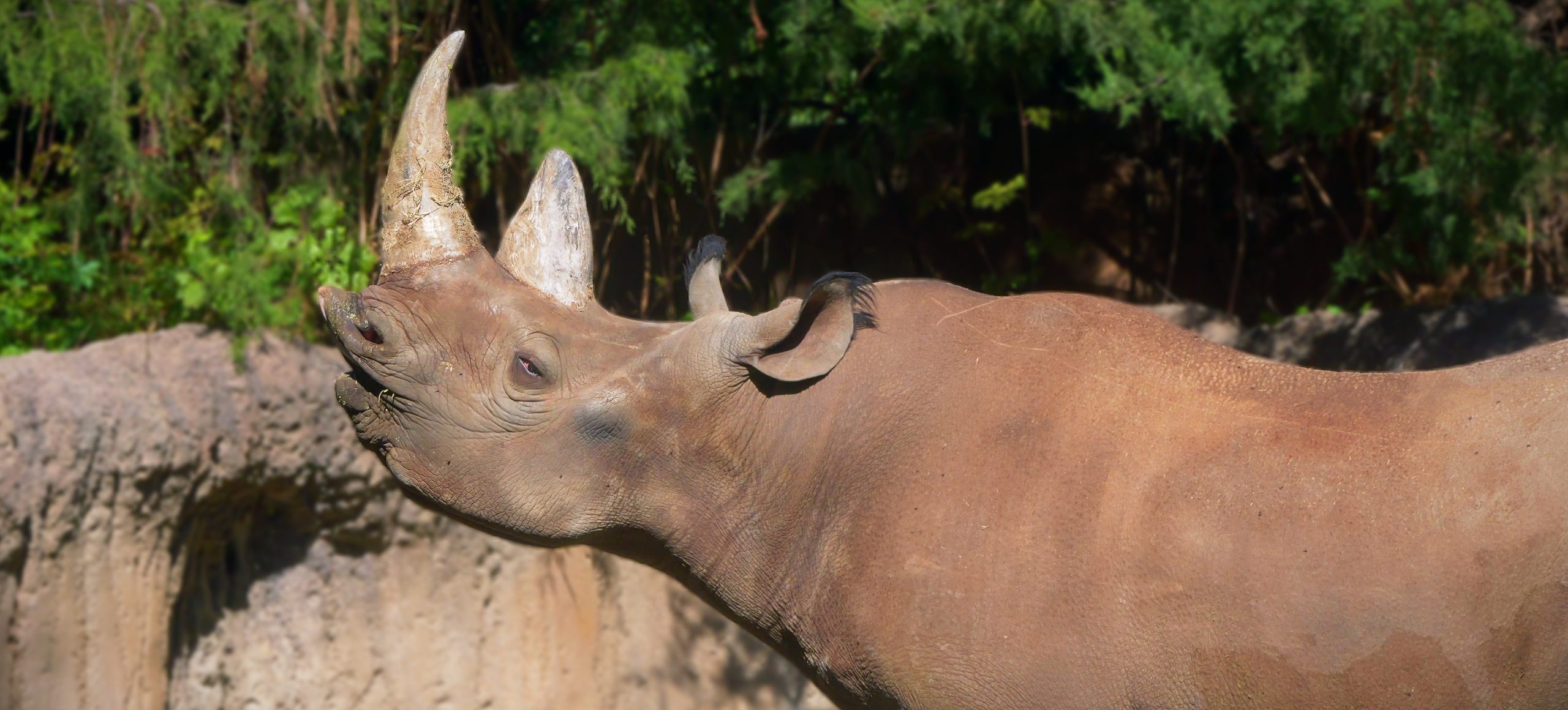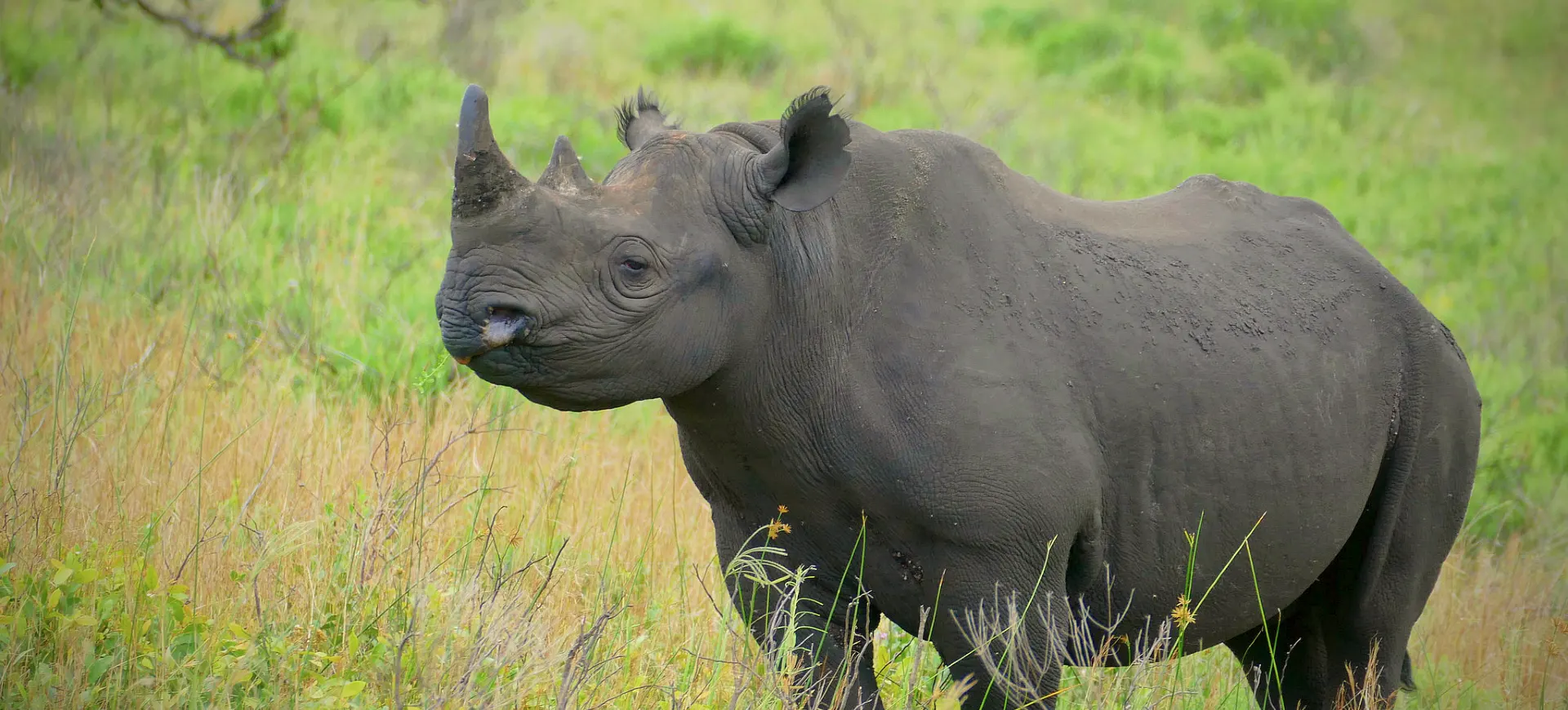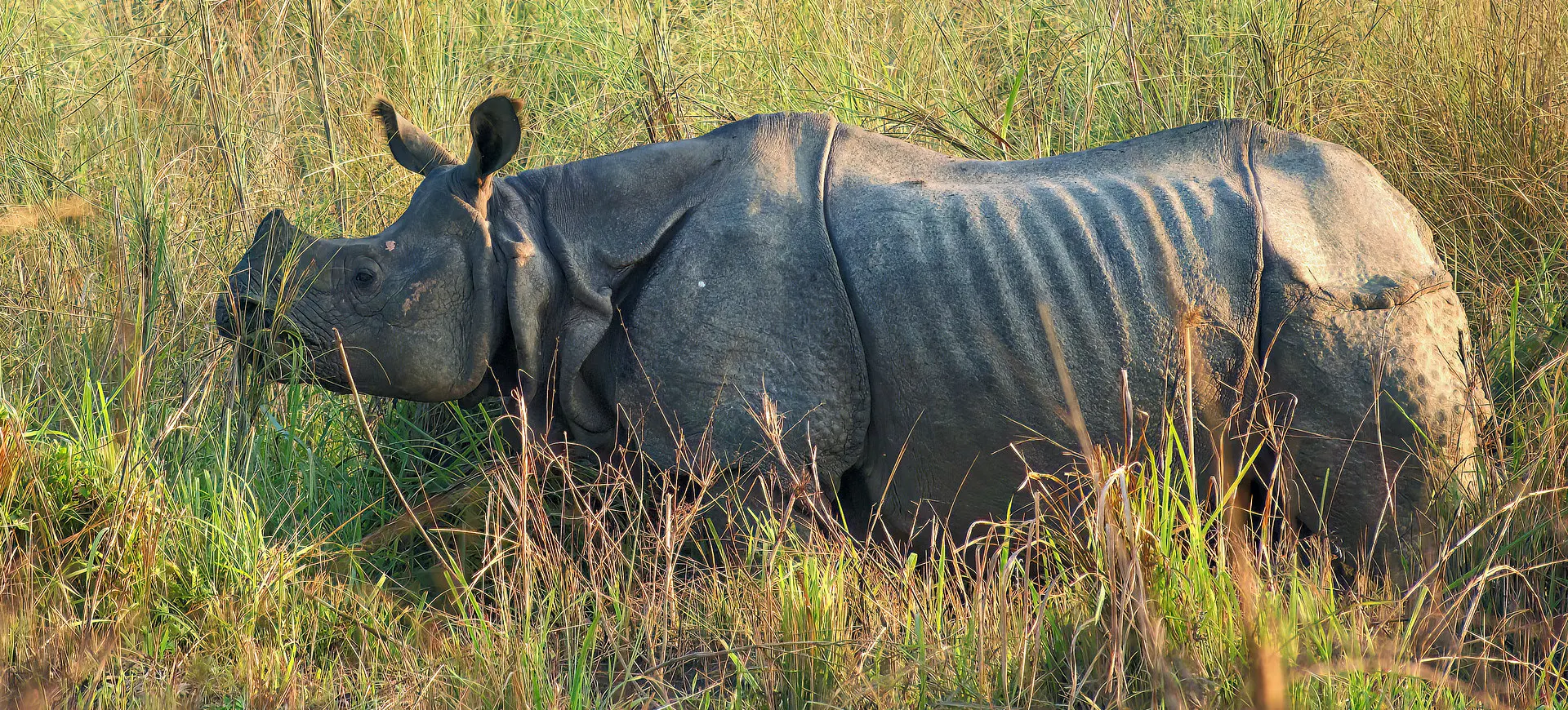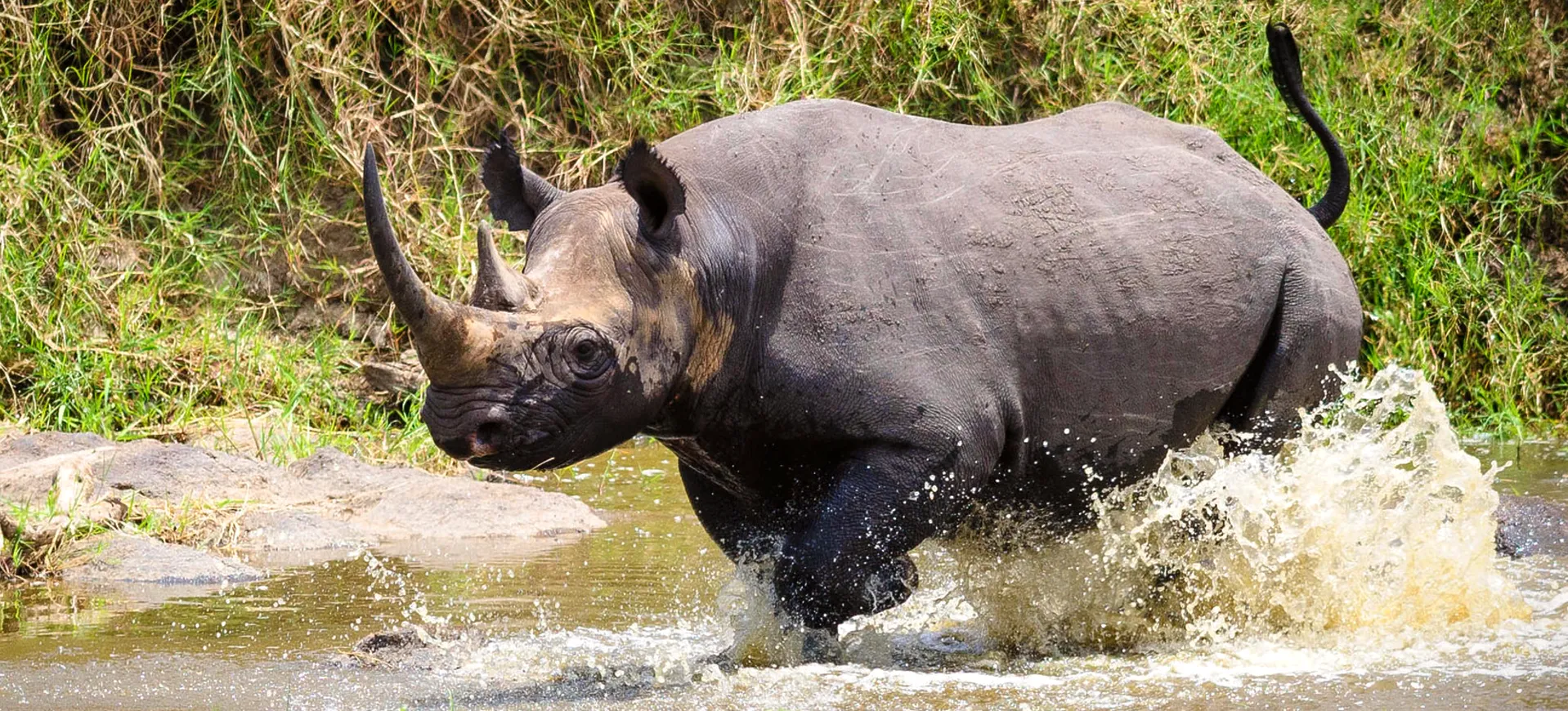Overview
The Southern White Rhinoceros (Ceratotherium simum simum) is one of the two subspecies of the white rhinoceros, the other being the Northern White Rhinoceros. Among the five extant species of rhinoceros, it is the most populous and arguably the most successful in conservation efforts. The Southern White Rhinoceros is distinctive for its size, second to the elephant among land mammals, and its distinguishing double horn. This rhinoceros subspecies has a broad, straight mouth adapted for grazing and a hump of muscle on the back of its neck.
This enormous creature possesses a body shape similar to a tank, robust and compact. Its skin is roughly textured, somewhat akin to an armor, grayish in color, and susceptible to sunburn. To counteract this, the Southern White Rhinoceros often takes mud baths to protect its skin. Its head is large and elongated, adorned with two pointed horns that differ in size. The longer anterior horn, or the primary one, measures up to 150 cm, while the posterior one, or the secondary, is shorter.
Despite its bulky size and seemingly unwieldy form, the Southern White Rhinoceros is surprisingly agile. It can run up to considerable speeds and make sharp turns at full speed. Moreover, despite its poor eyesight, it has a strong sense of smell and hearing, which it relies upon for communication, navigation, and detecting potential threats.
Taxonomy
Kingdom
Phylum
Class
Order
Family
Genus
Species
Sub Species
Type
Physical Description:
The Southern White Rhinoceros exhibits sexual dimorphism in size, with males being larger than females. Males have a head-and-body length ranging from 3.7 to 4.2 meters, while females typically measure from 3.4 to 3.65 meters. Despite this significant size, the creature maintains impressive physical agility and distinct graceful movement. Its body is compact, with a characteristic barrel shape that appears well-suited for its immense weight.
The rhinoceros has a pair of horns on its snout, the larger of which is positioned anteriorly. These horns are made of keratin, similar to human hair and nails, and can grow throughout the rhinoceros’ lifetime. The anterior horn usually grows larger, ranging from 90 to 150 cm, while the posterior is shorter. This rhinoceros has a wide mouth used for grazing, with a square shape, which earned it the moniker “square-lipped rhinoceros.”.

Lifespan: Wild: 40-50 years || Captivity: ~50 years

Weight: Male: 4,400-5,000 lbs (2,000-2,300 kg) || Female: 3,500-4,600 lbs (1,600-2,100 kg)

Length: Male: 12-13 ft (3.7-4 m) || Female: 11-12 ft (3.4-3.65 m)

Height: Male: 66-73 inches (170-185 cm) || Female: 62-67 inches (160-170 cm)

Top Speed: 31 mph (50 km/h)
Characteristic:
Native Habitat:
The Southern White Rhino, primarily residing in southern and eastern Africa, is adept at thriving in various ecosystems, including expansive grassy savannas and woodlands interspersed with grassy clearings. Savannas provide abundant nutrition in the form of grass and trees for shade, while the woodlands offer grazing opportunities in open spaces. Their flat, broad lips are specially adapted to grazing, demonstrating their remarkable adaptability to these environments.
Water forms an essential part of the Southern White Rhino’s habitat, necessitating daily access for drinking and wallowing. Wallows, or areas with soft, eroded ground, allow the rhinos to roll in the mud, providing natural sunscreen and a deterrent against parasites. The ongoing encroachment of human activities into their habitats has seen them adapt to more human-altered landscapes, but their habitat must always provide grass, cover, and water.
Climate Zones:
Biomes:
Biogeographical Realms:
Continents:
Diet:
Diet & Feeding Habits:
The Southern White Rhinoceros is primarily a grazer, feeding mostly on grasses. It uses its wide, flat lips to pluck grass from the ground, consuming large amounts to sustain its massive size. Unlike its black rhinoceros cousin, the white rhinoceros lacks a prehensile lip, therefore, is not equipped to eat leaves and branches from shrubs and trees.
This rhinoceros has a specific routine when it comes to feeding. It grazes during the coolest parts of the day: early morning, late afternoon, and nighttime. During the hot midday hours, it tends to rest in the shade or wallow in mud to cool down. Its diet primarily consists of short grasses, but it is also known to consume longer grasses, especially in the wet season when these are readily available.
Mating Behavior:
Mating Description:
The mating behavior of the Southern White Rhinoceros is complex, involving aggressive interactions and tender courtship rituals. Males compete fiercely for the attention of receptive females, often engaging in brutal battles that may result in severe injuries once a male has established dominance and won the favor of a female; courtship begins, characterized by the male following the female closely, occasionally touching her with his nose or nuzzling her.
Females enter estrus every 30 days, and the mating period usually lasts 20 to 30 minutes. The female signals her readiness to mate by urinating frequently and allowing the male to approach her. After successful mating, the female will conceive and begin a lengthy gestation period.
Reproduction Season:
Birth Type:
Pregnancy Duration:
Female Name:
Male Name:
Baby Name:
Social Structure Description:
Southern White Rhinoceroses are generally friendly creatures, although adult males are more solitary than females and young. Females and their offspring often form groups, known as ‘crashes,’ consisting of up to a dozen individuals. Young males may form bachelor groups until they can establish their territory.
Adult males are territorial and mark their territory with dung piles and urine sprays. They defend these territories fiercely against rival males. Communication between individuals involves various vocalizations, scent markings, and postures.
Groups:
Conservation Status:
Population Trend:
The Southern White Rhino, while the most populous of rhino species, faces serious threats to its survival. Habitat loss is a key issue, largely driven by human activities. As expanding agriculture, infrastructure development, and changes in land use transform their natural habitats into areas unsuitable for wildlife, the rhinos lose critical grazing and wallowing sites. Additionally, poaching presents a grave danger. The illegal hunting of these animals for their horns, driven by black market demand for use in traditional medicines and ornamental carvings, has drastically impacted their numbers.
However, it’s not all bleak for the Southern White Rhino. Over the past century, intensive conservation efforts have produced a remarkable turnaround in their fortune. In the late 19th century, fewer than 100 individuals were estimated to exist, but persistent and targeted measures have helped the species bounce back. Conservation strategies like stringent law enforcement against poaching, establishing protected areas, translocation to spread the risk of extinction, and community-based conservation initiatives have been key in this recovery. As a result, their numbers now stand at around 10,000, a testament to what focused conservation work can achieve.
Population Threats:
The major threats to the Southern White Rhinoceros population are poaching and habitat loss. The species is hunted illegally for its horn, which is highly valued in certain cultures for its alleged medicinal properties and as a status symbol. In addition, expanding human settlements and agricultural activities are encroaching upon the rhinoceros’ habitat, reducing the available space and resources for the species.
Climate change is an emerging threat, with changing weather patterns potentially impacting the rhinoceros’ grassland habitat and food resources. Disease outbreaks also pose a risk to the population and conflict with humans when rhinoceroses stray into human-populated areas.
Conservation Efforts:
Conservation efforts for the Southern White Rhinoceros have been intensive. They have included strict law enforcement to combat poaching, habitat protection and management, and establishing translocation programs to reintroduce the species into parts of its former range. These efforts have successfully brought the species back from the brink of extinction and resulted in significant recovery.
However, ongoing efforts are needed to secure the species’ future. This includes continued anti-poaching measures, community engagement to reduce human-wildlife conflicts, research and monitoring to track the population’s status and threats, and measures to address the impacts of climate change on the rhinoceros’ habitat.
Additional Resources:
Fun Facts
- Southern White Rhinos have the widest set of nostrils of any land-based animal.
- They have poor eyesight but an excellent sense of smell and hearing.
- Despite their large size, they can run up to 31 mph (50 kph).
- They communicate using various vocalizations, including growls, grunts, and bellows.
- Unlike most mammals, female rhinos are larger than males.
- They love to wallow in mud to cool off and protect their skin from the sun and biting insects.
- Their gestation period is one of the longest of any mammal – 16 months.
- The larger front horn of a rhino can grow up to 59 inches (150 cm) long.
- Rhinos have a symbiotic relationship with oxpeckers, birds that eat ticks and alert rhinos to danger.
- A rhino’s horn is made of keratin, the same material as human hair and nails.


